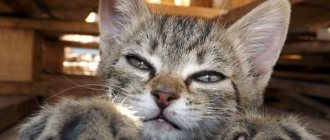Catnip is a valuable remedy in cases of respiratory tract infection. Drinking hot herbal tea made from catnip increases sweating and hence effectively reduces fever and also acts as a natural remedy to reduce congestion. This plant is useful during bronchitis and asthma, as well as viral skin rashes such as chicken pox or measles.
Health benefits of the plant
Catnip is an excellent natural remedy for babies and young children. Thanks to its calming properties, it helps relieve anxiety and improves sleep. Its sedative effect is also felt within the gastrointestinal tract, meaning this herb relieves tension and colic, bloating or pain. It is also an excellent herbal remedy for young children who suffer from colic or have trouble sleeping. A strong infusion of catnip will relieve headaches caused by stress and tension in the nervous system. Catnip can also be used successfully for other ailments of the digestive system, such as stomach pain or indigestion, poisoning. Due to its tannin content, catnip is a good remedy for diarrhea, especially in children.
Catnip also helps in the form of an enema for intestinal inflammation, constipation or diarrhea. Due to its relaxing properties, catnip also has a beneficial effect on the uterus, and therefore this herb can be used to relieve menstrual cramps as well as symptoms of premenstrual tension. The herb is suitable for regulating menstruation or in cases where menstruation is delayed. A hot infusion of the herb is an excellent antiseptic for inhalation for sore throat, colds, flu, cough; the infusion eliminates congestion during a runny nose and sinusitis, and is a sedative during asthma attacks and inflammation of the larynx, bronchi and trachea.
This plant belongs to the herbs that have disinfectant properties, i.e. it is excellent for treating skin infections. Tannic acids contained in the herb accelerate tissue healing, and also have the properties of inhibiting bleeding from small wounds, helping with the healing of burns, hemorrhoids, and insect bites.
Application
The main component of catnip, nepelactone, is very similar in its chemical structure to the tranquilizers found in valerian. This explains why drinking a cup of hot catnip tea makes you feel sleepy. This plant will ensure healthy and restful sleep. In a study of laboratory mice fed catnip, it was observed that the mice were less active and slept much longer.
In order to create a real and effective drink that will help you get a good night's sleep, you need to boil 1/2 glass of water. Remove from heat and add 1 teaspoon fresh or dried catnip to the water and let steep for about 20 minutes. The drink should be drunk warm. You can add honey. This drink can also be drunk in cases of insomnia, fever, hay fever and nausea. A small cup of catnip tea with honey is a great way to calm hyperactive children.
Residents of the sparsely populated Appalachian region use crushed leaves of fresh grass, as well as herbal powder, as a compress on sore gums or teeth. To apply the herbal powder, gauze or cotton cloth soaked in water is used, onto which the herbal powder is poured, after which the compress is applied to the sore tooth or massaged into the sore gums to obtain quick pain relief. It should be noted that fresh mint leaves provide quick pain relief, while dried leaves (powder) last longer.
Strong catnip tea can also be used as an effective lotion for puffy eyes, such as due to allergies, colds, flu, or after drinking large amounts of alcohol. Bring 3 cups of water to a boil, then add 5 teaspoons of fresh catnip leaves. Reduce heat and steep the drink for 3 minutes. Remove from heat and leave for about 50 minutes. Strain, pour the liquid into a glass jar or bottle and refrigerate. Use as an eye lotion or gargle several times daily. You can also soak a small towel in the lotion and place it on your swollen eyes for about 30 minutes.
What is catnip
An unpretentious herbaceous perennial plant belonging to the Lamiaceae family is called catnip (nepeta cataria). The grass grows on a high tetrahedral stem from 0.5 to 1 m, has triangular-ovate drooping leaves. Wild catnip is a creeping plant. At each contact with the soil, the stem produces new shoots that take root, thereby forming thickets. Plants bloom in summer (June-July).
This herb has many different names, in addition to the one accepted in botany - catnip. People came up with them based on the properties of the plant. Because the grass is liked by domestic cats, it is also called cat drink, cat grass, or cat grass. A spicy smell is indicated by mint catnip, fragrant horehound, budra, and lemon dakhts. Due to its healing properties, the plant is called field balsam or matoshnik. Mint products can be purchased at many pharmacies.
Growing catnip and caring for the plant
This plant is unpretentious and does not require much time and effort to care for. Catnip is grown using seeds or seedlings, as well as by dividing bushes.
Seed propagation involves planting seeds in open ground. The distance between rows should not be less than thirty centimeters. They are buried one centimeter into the soil, and thinned out at the first shoots. Removed sprouts can be transplanted to another location.
If you plan to plant the plant using seedlings, then the seeds are planted in small containers. And when the first pair of true leaves appears, it is necessary to transplant the seedlings into the soil, followed by fertilization. But at the same time, it is worth knowing that you need to replant the plant when frost is no longer expected.
The plant is propagated by dividing the bushes or dividing the roots every three to five years. To do this, you need to dig up the plant, carefully clean the roots, divide them into several parts and plant them separately from each other. You should pay attention to the fact that each plant should have three to four buds and roots.
Catnip care involves regularly watering the plant, loosening the soil, and fertilizing. The plant is most often fed with compost, humus and various mineral complexes.
Such a plant rarely gets sick, but if it is over-watered, powdery mildew may appear. It is easy to get rid of it with the help of various insecticides, but only if the grass is not eaten.
The smell of catnip repels pests, so you shouldn’t expect problems from this side. The only ones who are not afraid of its aroma are cicadas, but they do not cause much harm to the plant.
Catnip for humans
The plant is considered an excellent natural remedy for babies. Thanks to its calming properties, it helps against insomnia and reduces anxiety. This effect is also felt in the stomach - pain and bloating are relieved. A strong mint decoction relieves headaches and relaxes the nervous system. Thanks to the tannins it contains, the catnip plant is good for diarrhea and, like an enema, for constipation. A hot infusion that contains essential oils works as an antiseptic for sore throats, colds, and soothes during asthmatic attacks.
Why cats love her
The secret why cats love catnip so much and its aroma, while they remain indifferent to others with a similar smell, has long been revealed. Our pets are attracted not by the aromatic smell itself, but by its source - nepetalactone.
This substance affects the neurons of the cat's brain, causing short-term hallucinations and changing the animal's behavior pattern.
It is difficult to predict exactly how a pet will behave under its influence. Different effects are observed. A passive animal can begin to play actively, and a violent one can calm down.
The video clearly demonstrates possible reactions:
The use of catnip in folk medicine
In European countries, catnip is used as a spice in cooking, and drops of oil are an indispensable ingredient in the manufacture of sweets and perfumes. The healing properties are used in folk remedies both inside the body and outside. Internal use has an antitussive, soothing, anthelmintic effect, external use saves from skin diseases. The effectiveness of using plant extracts to increase appetite in sprays for bronchitis has been scientifically proven.
For digestion
In case of malfunctions of the gastrointestinal tract, discomfort, gastritis, spasms, take catnip decoctions. To prepare it you will need 1 tsp. dried herb, pour a glass of boiling water, leave for 2-3 hours (preferably in a thermos). Then the mixture is filtered and 1 tbsp is taken. l. 3 times a day half an hour before meals. This plant also stimulates appetite.
For a cold
Herbal tea is considered one of the best remedies against colds. It is drunk both at the onset of the first symptoms and during the acute course of the disease. To prepare tea you need to pour 1 tbsp. l. dry herbs 500 ml of boiling water and leave for 20-30 minutes. Then strain everything through a sieve, add honey and lemon to taste, and drink as tea. It is convenient to brew in a kettle, thermos, coffee maker, or saucepan.
For skin diseases
To treat various skin diseases (inflammation, boils, rashes), you will need to make a collection of the following plants in equal proportions:
- cat grass;
- blueberries;
- gentian;
- fenugreek;
- St. John's wort;
- verbena;
- donkey grove;
- comfrey.
To prepare the tincture 3 tbsp. l. The above ingredients must be poured with 2 cups of boiling water, leave for 30-40 minutes, then strain through a sieve. Take 60 ml 3 times a day after meals. For the first few days, administration is carried out once a day in order to monitor the body’s reaction and avoid allergic reactions to the multicomponent collection.
Hemostatic
Cat mint is boiled and used for uterine bleeding to stop hemorrhage. To prepare the product, take a full spoon of fresh mint leaves, pour a glass of boiling water, and let the whole thing infuse for 2 hours. The strained liquid is taken 0.5 cups 3-4 times a day before meals. Doctors recommend doing this only in emergency cases.
Catnip literally delights our cats, but also has many benefits for humans. For our feline friends it is a real "drug", albeit a useful one because it has no harmful effects and is not addictive, but for us it is a mild sedative with a digestive effect.
Can cats have catnip?
Some owners doubt whether it is possible to give cats catnip, since its effect is very similar to a narcotic. In fact, there is no dependence on this plant, and with frequent use, it completely ceases to attract the pet.
Benefit
Ingesting catnip is not necessary. The effect is achieved even when sniffing it and fades away quite quickly, therefore, in the absence of contraindications, it can be freely used to achieve the following goals:
- behavior correction;
- stress relief;
- increased appetite;
- improving the digestion process during stomach pain and cramps;
- training (used as a reward);
- prevention of helminthiasis.
The benefits of catnip for cats are undeniable, which is why it is often added to food and toys. It can also be easily grown at home.
Harm and contraindications
Catnip does not have a negative effect on the central nervous system and gastrointestinal tract, but still has some contraindications. These include:
- Pregnancy. Severe overexcitation when carrying kittens is fraught with premature birth and miscarriages.
- Hypersensitivity to the main components. An overreaction to catnip can lead to exhaustion of the nervous system.
If your pet behaves too violently or apathetically when using the plant, then it is better to avoid using it. In this situation, you should not wait until you get used to it, as this can harm your pet.
Descriptions and photos of the plant - catnip
Botanical name: nepeta cataria, cataria vulgaris, xalamintha albiflora, glechoma xataria, catnip, catnip, cat grass.
Catnip is an herbaceous perennial plant from the mint family that grows from 90 cm to 1.4 m in height. It has straight, green, square-shaped stems with brown-green foliage. The leaves have curly edges (triangular to ovate), with gray-white hairs on the underside. The fragrant flowers are small, white with spots of pale pink or purple, and bloom from late spring to mid-autumn.
There are about 250 species of plants in the Lamiaceae family, known collectively as catnips. Most of them are perennial plants that grow in height from 30 cm to 1 m. The catnip family grows in Europe, Africa and South-West Central Asia, in Russia it is distributed throughout almost the entire European part, in the North Caucasus, in the south of Western Siberia and the Far East, and was also naturalized in North America. Some are grown as ornamental plants that attract birds, bees and butterflies.
Most people associate catnip with its effects on cat behavior. However, if the plants in your garden are not damaged, cats will most likely not be interested in them. But some cats will roll around near the plant, meow, and even eat the plant, after which they fall into a relaxed, sleepy state. The thing is that big cats, such as lions, have inherited a specific gene - nepetalactone, which leads to such a sensitivity to the aroma of catnip. Cats that are younger than six months old and cats that have not carried this gene since birth do not have any reaction to catnip.
Why doesn't my cat react to catnip?
It was already mentioned above that the reaction to catnip can be different, and sometimes it is completely absent. If your pet does not show interest in the plant, this can be explained by one of the following reasons:
- Absence of a specific gene. Only 70% of mustachioed pets are susceptible to the smell of the plant. The remaining 30% are indifferent to it and pass this feature on to their children.
- Young age. The effect is observed only in sexually mature individuals, since kittens are not yet familiar with sexual heat.
- Severe stress. Catnip is used before encountering stress factors, and not during.
- Low essential oil content. It is observed in products with low-quality raw materials, so be sure to look at the reviews of other customers.
In the last 3 cases, the lack of reaction is temporary, and in the first - permanent. If your cat is in that same 30%, then her kittens are likely to be exactly the same.
Conditions for growing catnip
Catnip is a plant that prefers partial shade. However, several hours of direct sun per day is necessary for good growth. When planted in moist, well-drained, moderately enriched soil, catnip will grow thickly. If you pinch off the flower buds, it will grow bushier, and when you think the plant is getting too large or patchy, you can trim it back.
Catnip has tiny seeds that self-sow. Therefore, it will appear every year naturally. It can also be grown in pots if weather conditions or lack of space do not allow this to be done in the garden.
Fresh leaves can be collected at any time, but young leaves are best collected before flowering, then they are milder in taste. To dry mint, you need to cut off the stems, leaves and flowers as close to the ground as possible. Hang them in the shade with the flowers facing down, and after they dry, peel off the leaves, place them in an airtight jar, and store them in a dark place.
How to properly give catnip to your cat
In veterinary pharmacies and pet stores, catnip is sold not only in dry and fresh form, but also inside toys - in the form of dense balls and spray. Each type has different effectiveness.
Dry or fresh
Dry and fresh catnip is used as an everyday treat and for training. First, the leaves are rubbed in your hands to enhance the aroma and laid out on the desired surface: a sleeping place, a scratching post, or on a long-forgotten toy.
For cats, fresh catnip is preferable, as dry catnip has a weaker effect. The quality of raw materials also plays an important role. Only the leaves produce the aroma, so too many stems will reduce the overall effectiveness. Therefore, it is better to grow the plant at home.
In toys or balls
Catnip in its “live” form is the most effective, but it leaves a lot of dirt behind. Dried leaves crumble into fine dust, and the living plant often ends up toppled over.
If the presence of dirt is critical for you, pay attention to soft toys stuffed with aromatic plants. Their only drawback is their fragility. After drying, the leaves stop emitting aroma, so the toys require regular replacement.
Another interesting option is a hard and dense ball consisting of catnip and beeswax. Unlike soft toys, it is completely natural. You can even eat it, so you can easily combine a fun game with a nice meal.
In sprays - as an adjuvant
Catnip is even sold in spray form. It contains the essential oil of the plant and water, so the effectiveness is much lower than dry and fresh leaves. If, in addition to dirt, you are annoyed by toys and balls lying around everywhere, then this option is for you.
Catnip spray is used to acclimate cats to scratching posts and to calm them down before their next trip to the vet. Despite the presence of water, this product does not cause fear or rejection when sprayed directly onto the fur coat.
Medicinal uses of catnip
The use of catnip for medicinal purposes is negligible, as over time it has been surpassed by stronger or more effective drugs in modern medicine. However, catnip has been used to treat a variety of health problems, whose active components, including nepetalactone, are similar to the sedative properties of valerian root.
Traditionally, catnip was used at the first sign of colds and flu, to relieve tension from headaches, digestive problems, and to relieve menstrual cramps. There is an assumption that rubbing catnip tincture has a beneficial effect on joint arthrosis. Generally, the herb has a mild calming effect and reduces anxiety.
Catnip also has antiseptic properties that help heal small wounds, cuts, insect bites and other minor skin inflammations.
Native Americans from the Appalachian region used crushed fresh leaves to relieve toothache. The active ingredients are released by steam distillation.
Useful properties of catnip
The best way to consume catnip is by drinking tea. At the same time, you will receive all the wonderful components contained in the plant: vitamins A, B and C, calcium, iron, magnesium, manganese, phosphorus, potassium, selenium and sodium.
Herbal sedative
The main benefit of catnip tea is its calming effect. It can relax, relieve stress and anxiety, and calm the nerves without sedation. Like most herbal teas, catnip tea does not contain caffeine. This tea can be used to treat insomnia.
Nepetalactone - thanks to this substance, catnip tea acts as a sedative and has a calming effect, relieving migraines and headaches.
2. Helper for digestive disorders
Herbal catnip tea helps with stomach problems as it is a natural anti-acid agent and helps reduce acid reflux, thus soothing an upset stomach. Catnip will help with colic, diarrhea, cramps and flatulence. Catnip tea is a good antispasmodic; it soothes the abdominal muscles and helps in the treatment of stomach ulcers.
Medicine for colds and fever
In addition to being an excellent natural sedative, catnip also has antibacterial and anti-inflammatory properties, which helps treat colds, allergies and upper respiratory tract inflammation.
Hot catnip tea helps reduce fever by inducing sweating and also acts as a decongestant by thinning mucus and soothing respiratory distress. Take this tea as soon as you feel the first symptoms of a flu or cold. This will relieve fever and relieve nausea.
Tea is useful for bronchitis, serves as a good inhalation remedy for coughs and sore throats, is an excellent relaxant for asthma, and helps with sinusitis.
Where to buy and how much it costs
If the idea of gardening doesn't appeal to you, catnip grass is available at almost any pet supply store. Therefore, the question of where to get grass for cats is easily resolved. These will mostly be sachets of dried leaves and flowers or an extract in liquid form.
For 15 grams of dry purring pleasure you will have to pay about 140 rubles.
It is more convenient to use a spray, but its price is more expensive - around 300 rubles per 100 ml.
Whatever form the catnip is purchased in, the packaging should be sealed tightly. The essential oil evaporates over time, rendering the herb ineffective.











